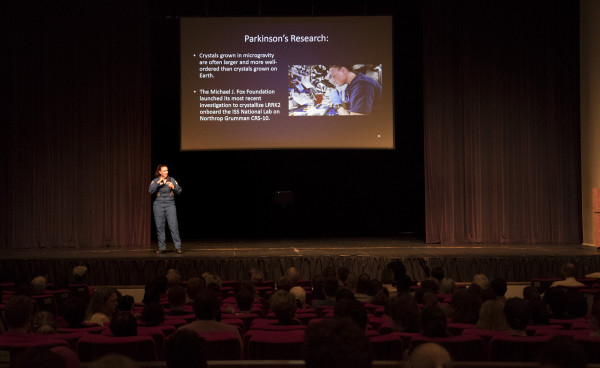Tales from orbit: NASA astronaut lands at Tech

Photo by DONNY CROWE/Louisiana Tech Communications
NASA astronaut Dr. Serena Auñón-Chancellor spoke at Louisiana Tech University’s Howard Auditorium Tuesday, kicking off Tech’s “New Frontiers in Biomedical Research” seminar series by highlighting the medical research she and her team performed during a recent six-month trip aboard the International Space Station.
For seven years, Louisiana Tech University’s “New Frontiers in Biomedical Research” seminar series has sought to bring renowned researchers from various fields to offer their insight to students and the community. But even among such company, it’s not every day one gets to hear from a woman who’s been to outer space.
That’s exactly what happened Tuesday as NASA astronaut Dr. Serena Auñón-Chancellor kicked off the 2019-20 series by speaking to attendees at Tech’s Howard Auditorium about the medical research she performed during a recent 6-month trip aboard the International Space Station.
Having begun working with NASA as a flight surgeon in 2006, Auñón-Chancellor’s career reached new heights when she was selected to be part of the threeastronaut Expedition 57 to the ISS from June 6 through Dec. 19, 2018.
During the 197-day stay above the planet, Auñón-Chancellor and her team participated in hundreds of experiments in biology, biotechnology, physical science and Earth science. She said Tuesday she wanted to dissipate a misconception about the focus of these experiments.
“A lot of people believe the medical science we do on the space station is all about space exploration — about helping us get to the moon and Mars,” she said. “But if you look at the list of topics we research, this has nothing to do with that. This has everything to do with your health here on this planet.”
Research topics included potential treatment advancements in cancer and Parkinson’s disease, as well as retinal implants for macular degeneration patients.
Most of these experiments were specifically sent to orbit because the low-gravity environment allows for research conditions not replicable on Earth.
For example, endothelial cells needed for chemotherapy testing grow more perfectly in microgravity because such conditions mimic the suspension these cells experience in the human body.
“They thought the space station could actually serve as a model system to test some of these medications,” Auñón-Chancellor said. “And sure enough, they were right.”
Most of the companies for whom her team performed experiments are relatively small organizations, including one run by three people in their early twenties. Multiple times throughout her presentation, Auñón-Chancellor encouraged students in attendance to join NASA’s efforts.
“These aren’t big pharmaceutical companies with millions of dollars,” she said. “These are just people with an idea. Those of you who think you might have an experiment you want to send to the space station: it’s not impossible.”
Earlier in the day Tuesday, Auñón-Chancellor took the time to visit and read to a crowd of A.E. Phillips Laboratory School and Early Childhood Education Center students on Tech campus.
At the lecture, Auñón-Chancellor also highlighted the future of NASA, beginning with the ongoing Artemis program.
Bornoutof theTrump administration’s Space Policy Directive 1 in 2017, Artemis is NASA’s plan to put the first woman and next man on the moon by 2024, with the goal of establishing a sustainable, long-term presence on the moon and preparing for eventual Mars exploration.
“The clock is ticking,” she told students. “Do we need more workers, students, chemists, engineers? Yes. As fast as you can come join us at NASA, please do. We need you.”

